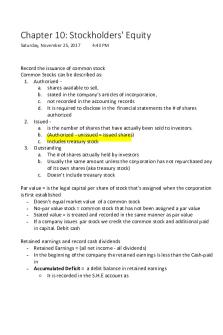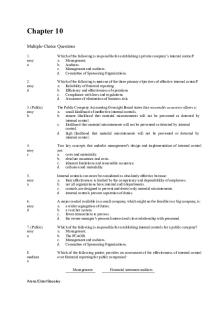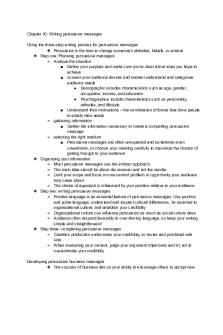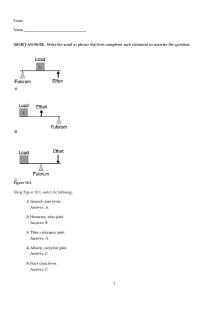Chapter 10 stockholders\' equity PDF

| Title | Chapter 10 stockholders\' equity |
|---|---|
| Course | Financial Accounting Information |
| Institution | The University of Tampa |
| Pages | 2 |
| File Size | 49.4 KB |
| File Type | |
| Total Downloads | 6 |
| Total Views | 155 |
Summary
These notes are from lectures in financial accounting, chapter 10...
Description
Paid-in capital: amount stockholders have invested in the corporation Retained earnings: amount of earnings the corporation has retained RE Beginning + Net Income - Dividends = RE End Treasury stock: corporation’s own stock that it has reacquired
PUBLIC
PRIVATE
Allows public investment
No public investments
More stockholders
Fewer stockholders
Regulated by the SEC
Not regulated by the SEC
Advantages of having a company go public: 1. Limited liabilities 2. Ability to raise capital and transfer ownership Disadvantages of having a company go public: 1. Additional taxes 2. More paperwork and rules Par value: legal capital per share of stock that’s assigned when the corporation is first established ***When doing a journal entry for par value, debit cash (number of shares times share price) and credit common stock (number of shares times par value) and additional paid-in capital (the rest)*** Features of Preferred stock 1. Convertible: shares can be exchangeable for common stock 2. Redeemable: shares can be returned to the corporation at a fixed price 3. Cumulative: shares receive priority for future dividends if dividends are not paid in a given year Companies buy back their own stock for various reasons: 1. To boost underpriced stock 2. To distribute surplus cash without paying dividends 3. To boost earnings per share 4. To satisfy employee stock ownership plans
***when doing an entry for purchasing treasury stock, debit treasury stock (number of shares times cost per share) and credit cash*** ***Entry for issuance of treasury stock debit cash, credit treasury stock and credit/debit
additional paid in capital (number of shares times the difference in prices of shares) Dividends date Declaration date: date on which board of directors declares the cash dividend will be paid Record date: specific date on which the company will determine who will receive the dividend (registered owner of stock) Payment date: date of the actual cash distribution ***recording cash dividends (declaration date) debit dividends and credit dividends payable ***(payment day) debit dividends payable and credit cash...
Similar Free PDFs

Chapter 10 Stockholders\' Equity
- 8 Pages

Chapter 10 stockholders\' equity
- 2 Pages

Ch15-stockholders -equity
- 40 Pages

Maxims of Equity Equity Law
- 5 Pages

Chapter 10 quiz #10
- 3 Pages

Notes 10 - Chapter 10
- 5 Pages

Chapter-10
- 19 Pages

Chapter 10
- 5 Pages

Chapter 10
- 14 Pages

Chapter 10
- 111 Pages
Popular Institutions
- Tinajero National High School - Annex
- Politeknik Caltex Riau
- Yokohama City University
- SGT University
- University of Al-Qadisiyah
- Divine Word College of Vigan
- Techniek College Rotterdam
- Universidade de Santiago
- Universiti Teknologi MARA Cawangan Johor Kampus Pasir Gudang
- Poltekkes Kemenkes Yogyakarta
- Baguio City National High School
- Colegio san marcos
- preparatoria uno
- Centro de Bachillerato Tecnológico Industrial y de Servicios No. 107
- Dalian Maritime University
- Quang Trung Secondary School
- Colegio Tecnológico en Informática
- Corporación Regional de Educación Superior
- Grupo CEDVA
- Dar Al Uloom University
- Centro de Estudios Preuniversitarios de la Universidad Nacional de Ingeniería
- 上智大学
- Aakash International School, Nuna Majara
- San Felipe Neri Catholic School
- Kang Chiao International School - New Taipei City
- Misamis Occidental National High School
- Institución Educativa Escuela Normal Juan Ladrilleros
- Kolehiyo ng Pantukan
- Batanes State College
- Instituto Continental
- Sekolah Menengah Kejuruan Kesehatan Kaltara (Tarakan)
- Colegio de La Inmaculada Concepcion - Cebu





